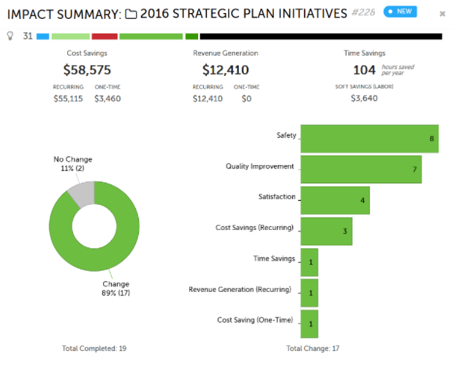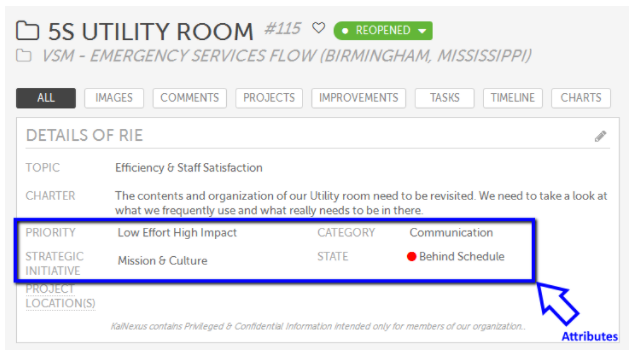Hoshin Kanri, also known as “strategy deployment” or “management compass,” is a Lean methodology for aligning strategy, measures, and improvement efforts across an entire organization. This means that every person from the front-line staff to senior executives understands the organization’s primary goals and strives to reach those goals through continuous improvement activities, both large and small.
Hoshin Kanri steers an organization toward long-term strategic objectives and intermediate goals while maintaining and improving key business processes and results through systematic planning and good organizational alignment.
KaiNexus empowers your entire organization to participate in your Hoshin Kanri deployment. There are only four elements that you need to master:
Projects
Projects group Improvements together, allowing you to organize your top-down work into groups that can be nested to further delineate relationships. Recall that you can configure different types of projects (VSM, RIE, Lean Project, PDSA, etc) made up of teams.
The different types of Projects can help create the cascading nature of the way the top-down work is all related to each other. For instance, you can configure KaiNexus to support your Goal/Strategy/Tactics vernacular, as well as your VSM, RIE, and Green or Black Belt Classes. Regardless of what large-scale efforts are going on in your organization, we can configure KaiNexus to support them and show how they fit into the bigger picture.
Improvements
 Improvements are the base unit of work in KaiNexus. They range from large units of work (e.g. A3s) to small ones (e.g. Just Do Its). Each completed improvement includes a resolution that logs the benefit to the organization.
Improvements are the base unit of work in KaiNexus. They range from large units of work (e.g. A3s) to small ones (e.g. Just Do Its). Each completed improvement includes a resolution that logs the benefit to the organization.
The benefit of taking the time to complete a Resolution for every improvement is two-fold:
- It changes habits to enforce making sure that every Improvement benefits the organization in at least some small way, and
- It creates a standard for how the benefits are being recorded.
In this way, KaiNexus provides a standard way to aggregate the impact of your improvement culture across the organization. It allows you to compare locations and get insight into top-down and bottom-up improvement.
Here is an example of the impact summary of an organization’s 2016 strategic plan. We can easily see the number of Improvements, the change rate, and the qualitative and quantitative benefits that the organization is seeing as a result of their strategic plan.
Attributes
You may have created attributes such as State (e.g. Behind Schedule) or Priority (e.g. Low) to help you quickly group initiatives and take action.
Attributes can also be used to categorize Improvements to tie them back to your True North, such as in the example below with the “Strategic Initiative” attribute. In this way, it becomes easy to see exactly which improvements are contributing to each initiative.

Boards
One of the benefits of Boards is that they become a place to gather to discuss the work and review KPIs. You don’t lose that ability with KaiNexus; by displaying your boards on screens rather than paper, a room full of people can not only see project lists and metrics, they can also dive into the details to get more information in real-time as needed.
Projects, Improvements, KPIs, and other charts can be shown on digital KaiNexus Boards to organize all of the work relating to a specific workflow, topic, or goal. You can configure your boards to show the relationships between Projects, Improvements, and KPIs in any way that make sense for your organization. Nesting your Boards under other Boards further improves the visual organization around how every improvement initiative cascades up into your “True North” pillars.
KaiNexus makes it possible to drill down into the details of any Project or Improvement to get updates, identify problems, and deploy resources. Compare that to a physical wall with printouts of Projects, Improvements, and metrics or searching for files buried in a shared drive somewhere. Without KaiNexus, your visibility is limited by your ability to walk or drive to each board, and once there, you’re often unable to drill down into the details. Additionally, Improvements and Projects appear on all applicable boards, breaking down silos across the organization.
To learn more, check out this webinar!



Add a Comment